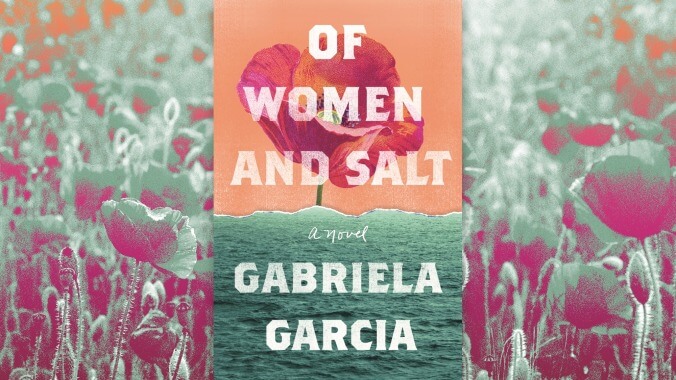Cover image: Flatiron Books Graphic: Natalie Peeples
The first thing one notices after opening Gabriela Garcia’s debut novel, Of Women And Salt, is a small family tree. Two, actually, displayed side by side, but not linked. One is more of a truncated stub, composed of only two members. The other is more expansive but by no means sprawling, unlike the kind you may find in other Latinx family sagas. And unlike Márquez’s labyrinthian Buendía situation, there are no notable father figures. These family trees are matrilineal through and through.
It’s a small detail but a significant one. This is a book that is obsessed with the narratives nations create to explain themselves, with the stories individuals weave to delineate their own existence. Even more so, it’s obsessed with the stories women hide from society, from their loved ones, sometimes even from themselves. This book announces from the outset that whatever it has to say about immigration, identity, addiction, family, and the idea of home, it will be from a strictly female perspective—and therefore positions itself as a counternarrative of sorts.
You can say Of Women and Salt centers Jeanette, the troubled daughter of a Cuban immigrant battling addiction in present-day Miami. When ICE raids her neighbor’s apartment, she decides to take in the elementary-schooled daughter, Ana, who has been left behind. This is how the destiny of the two families starts to collide. But the narrative doesn’t focus exclusively on this specific storyline. Instead, it jumps in time and geography, and to the different points of view of the women in each family. We follow Carmen, Jeanette’s mother who harbors a terrible secret from her past, as she gets ready for Thanksgiving. We get a glimpse of life in a detention center at the border. We go back in time to a cigar factory in pre-independent Cuba. Each chapter could easily function as its own self-contained short story, but together they weave a delicate, unifying thread: to be a woman is to be in a permanent state of exile.
The book is coming in hot, hitting the most-anticipated lists of The New York Times, Oprah Magazine, USA Today, and more. It holds the seal of approval from Roxane Gay, one of Garcia’s MFA professors, and a raving blurb from Terese Marie Mailhot. Soon it will take book clubs by storm, especially those who try to read their way out of some of the thorniest political issues of our time.
Garcia—herself the daughter of both Mexican and Cuban immigrants, but also a former migrant rights organizer—refuses to give an easy narrative about immigration. Here there are no uplifting stories about the American dream, no model minorities, no monolithic interpretations for a demographic that refuses easy categorizations. More pointedly, there are no mother martyrs, a figure that has been romanticized in debates surrounding immigration. What we get are complicated women who are forced to make complicated decisions, their children sometimes the sacrificial lambs of their own choices.
Garcia takes on big themes, but her approach to each of these timely issues is to aim for intimate moments as a way to illuminate the effect it has on individual lives. A poet by trade, Garcia loves to use an extended metaphor to explore the inner world of her characters, and she does so masterfully. The Cuban Revolution serves as a backdrop for a tale of domestic abuse, where the question of whose freedom is on the line drives much of the tension. An attempted rape is stopped by the presence of a dead female body. Carmen despairs over Jeanette’s addiction as she discovers a caged panther in her neighborhood, wishing she could sacrifice herself to free it. Gloria, the neighbor detained by ICE, finds comfort in birds as she waits for deportation—birds themselves symbols of migration. As she notes, “We are families made of bird and we will save one another because no one else is coming.” Whether imprisoned by state forces, male partners, or the grips of addiction, freedom proves elusive.
Garcia has a knack for providing pointed, often searing, sometimes humorous commentary on other hot-button topics like white privilege, the animosity within the Latinx community, and even the tense relationship between the prodigal Cuban Americans returning to the island and the family they left behind. One outstanding chapter centers on Ana’s observation of her clueless American ex-pat boss who prances around Mexico in a huipil. Another is introducing us to the wry voice of Maydelis, Jeanette’s Cuban cousin who knows exactly how to play American and European tourists for maximum benefit.
The power of these vignettes is such that it’s easy to forget all these disparate threads are supposed to amount to a unified whole. It’s perhaps for that reason that the main weakness of the novel is the underlying question of how these two separate families will become inextricably linked. Instead of driving the tension, it proves distracting, and by the time Ana’s and Jeanette’s fates meet again, it feels shoehorned—quite a contrast considering how most of the novel opts for quiet revelations. The ending feels rushed and with little breathing space to explore a resolution that could have been richer.
Also, for a novel that so fiercely traces the legacy that our mothers’ secrets leave behind, we rarely get fully fleshed-out relationships between the mother-daughter pairs that pepper the book. With the exception of Gloria and Ana, we are told the ties are fractured more often than we are shown how they have frayed. The book may fall short of its ambitious scope, but what it does achieve, it achieves well. Insightful without being didactic and profound while remaining accessible, it reminds us of the various forces that push immigrant women to seek self-determination.
Author photo: Andria Lo


 Keep scrolling for more great stories from A.V. Club.
Keep scrolling for more great stories from A.V. Club.